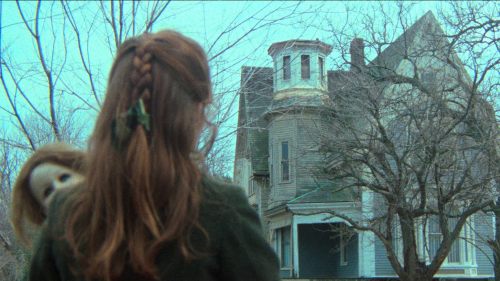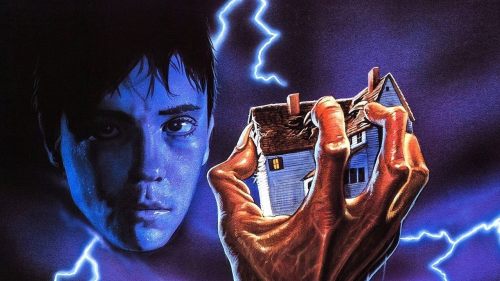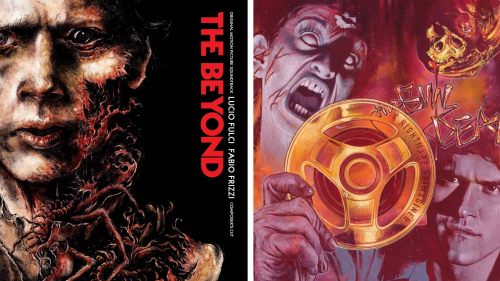Fulci Lives! A Beginner’s Guide to the Italian Sleaze Maestro
Lucio Fulci made art films.
Now, for those of you familiar with his body of work, this may seem like a ridiculous statement. But it’s true. A defining figure of the fast, cheap and ridiculous cinema that defined Italian exploitation during the 60s, 70s and 80s, Fulci made movies that focused on the visceral, to the point of obfuscating nearly every other element. Skin getting peeled off of a woman’s face as she falls over a cliff (naturally hitting every boulder on the way down) trumps character development. Another actresses’ eye being driven through a spike is more critical than narrative coherency. Dialogue takes a backseat to zombie brutality. To some, this may simply seem like ineptitude (and, to be fair, it is at times). However, Fulci was tapping into the ways cinema could be primeval rather than cerebral, becoming the godfather of avant-garde splatter. Combining a love of tangible death with hallucinatory visuals, his filmography takes on an almost otherworldly quality, most often scored by phantasmagorical virtuoso supreme, Fabio Frizzi.
Fulci began his career writing scripts and making rough docs such as Pittori Italiano dei dopoguerra (1948). During this time, he was mentored by the likes of Luchino Visconti, Roberto Rossellini, Federico Fellini, and Mario Bava. These collaborations yielded two results. One – Fulci learned how to perform technical tasks, which would later allow him to churn out films on the cheap. Two – the closeness to these Italian greats led to something of an osmatic bleeding, permitting the artist to soak in lessons regarding how to solidify one’s own visual fingerprint. With this hands-on schooling, he became the ultimate Italo-schlock director, able to combine a cutthroat ability to produce low-budget garbage without much effort, while still retaining his own sense of inventive self in the process. The increasingly violent nature of Fulci’s work could be contributed to the downward mental spiral he endured during the 70s – a result of his wife, Maria, committing suicide after being diagnosed with inoperable cancer in 1969. Compounding this existential grief was the car crash death of his daughter, Camilla, a few years later. Fulci was then diagnosed with severe diabetes and suffered with bouts of hepatitis, up until his death in 1996 at sixty-eight years of age. By that point, he had become a notorious figure in the world of horror and exploitation, going out of his way to lend his name to movies he hadn’t even directed in order to gain infamous notoriety. The auteur often joked that newspapers would misspell his name in his obituary out of spite for the “horror hack”. Some look to be revered; Fulci actually exploited being despised.
Ironically (but not surprisingly), Fulci’s legacy grew posthumously, as his work influenced numerous filmmakers, including Quentin Tarantino. Even in its infancy, Fulci’s cult following was an extraordinarily vocal one, as the neon spray-painted slogan “FULCI LIVES!” dotted numerous subway tubes in New York City, the American metropolis he often set his sleaze masterworks in. The following is a brief rundown of the best of Lucio Fulci’s work, for those looking to bathe in the depraved Italian master’s grime virtuosity during this Halloween season…
The Psychic (AKA Seven Notes in Black) [1977]
(w. Lucio Fulci, Robert Gianviti & Dardano Sacchetti)
A natural culmination of giallo thrillers A Woman in a Lizard’s Skin and Don’t Torture a Duckling, The Psychic combines Fulci’s signature hallucinatory visuals with an actual coherent plotline (while leaving behind the filmmaker’s anti-Catholic denouncement). After experiencing a haunting vision, a clairvoyant (Jennifer O’Neill) cracks open a wall in her new husband’s home, only to discover a rotten skeleton stuffed behind the plaster. Utilizing hazy, widescreen photography that the director no doubt picked up making Spaghetti Westerns such as Massacre Time, there’s a potent elegance that almost puts this in league with Dario Argento’s “animal trilogy” mysteries. However, the movie never becomes as overtly colorful or eye-popping, sticking with Fulci’s standard dark browns and shadowy hues (all punctuated with neon gore and eye line close-ups, of course). From this point forward, any formal sophistication would be progressively shed as Fulci trudged on, trading it in for gothic, blunt force unpleasantness as he crafted mean, uncompromising filth.
Zombi 2 [1979]
(w. Elisa Briganti)
Being Italian and working in the 70s exploitation industry meant that Lucio Fulci was pretty much morally required to make some sort of rip-off film. The fact that he may have created the most popularly recognized rip-off picture of all time only speaks to how good Fulci was at his job. Zombi 2 is an “unofficial sequel” to the George Romero/Dario Argento smash, Dawn of the Dead (whose box office doubled the picture’s $650,000 production budget before even being released in America). Only where Dawn was a candy-colored gore fest, Fulci’s blatant exercise in cashing in is brutal, drab and filled with stomach-turning awfulness (the trademark eye gouge here is vomit worthy). Fulci isn’t interested in social metaphors or lightheartedness, opting to revel in the ghouls’ voodoo origins before allowing us to witness one of the beasts going mano-a-mano with a pregnant, heavily medicated live shark. Yet for all of its putrid theft, Fulci again solidifies his position as being one of Italian schlock’s greatest visual masters, crafting sequences that would be referenced for decades after (the climactic “up from the grave” shot was shamelessly copied for Kill Bill). It’s a perfect example of trash fare crossing over to become legitimate art, due to the skill of the man behind the camera.
The Death Trilogy
City of the Living Dead [1980] / The Beyond [1981] / The House By the Cemetery [1981]
(w. Dardano Sacchetti, Giorgio Mariuzzo, Elisa Briganti & Lucio Fulci)
Considered by many to be his defining works, Fulci’s “trilogy of death” begins with the fog-drenched Gates of Hell (a/k/a City of the Living Dead) (during which a priest pukes out his own intestines), peaks with The Beyond (undoubtedly Fulci’s absolute best motion picture), and then comes down with the relentlessly inelegant (yet still overwhelmingly sad) House By the Cemetery. It’s an absurd trio that stands up against some of the very best Italo-sleaze produced in the country’s history. Shock enabler Fabrizio De Angelis (1990: The Bronx Warriors) played an integral part in producing two thirds of the maniacal triptych, however Fulci is going completely next level bombast with all three. Each picture rides in on a steamroller, as the director lenses it all with a tweedy goth attention to delivering spiders, gore, and a better trip than most LSD sold in the theaters showing the movies could offer. Absolutely essential viewing, the lot of ‘em.
The New York Ripper [1982]
(w. Gianfranco Clerici, Lucio Fulci & Dardano Sacchetti)
The New York Ripper is a tipping point within Fulci’s filmography, where he completely spills over into being a bona fide scandalmonger. Dirty, gross, misogynistic and incredibly effective, The New York Ripper is easily the most viscerally uncomfortable movie on this list. However, it also acts as a great companion to the works of William Lustig and Abel Ferrara as 42nd Street-level nightmare portraits of NYC in the late 70s and early 80s. This is a city that wasn’t safe to exist in – home to a Daffy Duck-voiced serial killer with a penchant for shoving knives into vaginas. Any air of Z-grade class is gone entirely; Fulci’s experimental elegance extinguished and replaced with a leering, lecherous lens (manned by Investigation of a Citizen Above Suspicion DP Luigi Kuveiller). If you make it through this one with a smile on your face (which this writer often does), you’re not only a deviant, but also a certified Fulci die-hard. This is cinema of perverse magnificence.
Murder Rock [1984]
(w. Gianfranco Clerici, Lucio Fulci, Roberto Gianviti & Vincenzo Mannino)
We never officially received a proper Lucio Fulci “musical” during the director’s lifetime, so Murder Rock is going to have to act as the next best thing. In order to capitalize on the success of Flashdance, producer Augusto Caminito “suggested” that Fulci combine a revenge giallo script (that echoes The New York Ripper almost beat-for-beat) with a Keith Emerson soundtrack. The results are odd, to say the least; a pelvic-thrusting slice of WTF insanity that truly cannot decide what type of film it wants to be. Campy song and dance picture? Brutal slasher? Yet one thing is clear: the movie is never, ever boring. The constant zooming in on dancers’ butts and crotches is probably not going to quell any complaints that Fulci was a raging misogynist, but if you’ve made it this far into the list, you’ve definitely learned to compartmentalize and reconcile the good with the very, very tacky.
Nightmare Concert (AKA Cat in the Brain) [1990]
(w. Lucio Fulci, Giovanni Simonelli & Antonio Tentori)
Call it Lucio Fulci’s 8 ½; Nightmare Concert is the director’s sad swan song, despite the fact he would make three “official” (and one uncredited) films after the fact. A mash of sequences taken from his own work, as well as several “Lucio Fulci Presents” pictures (namely Andrea Bianchi's Massacre, Enzo Milioni's Blood Moon, Leandro Lucchetti's Bloody Psycho, and Mario Montero's Don’t Be Afraid, Aunt Martha Won’t Hurt You), the footage combines with sequences of Fulci (playing himself) going mad while dreaming of murder. The wrap-around segments were filmed in Rome’s legendary Cinecittà Studios (where Fellini shot La Dolce Vita), as Fulci desperately pleads with his therapist to help him cease being hounded by the grisly sights of death. Taking the director’s mental slow demise into account, there’s an unsettling despondency that permeates the picture – a reflection on a career that was haunted by the specter of personal tragedy. In this way, Nightmare Concert almost backs conspiracy theorists that believe Fulci committed suicide by simply refusing to take his diabetes medication. The great beyond beckoned, and the maestro could no longer ignore the black cat that bounced about in his skull.



